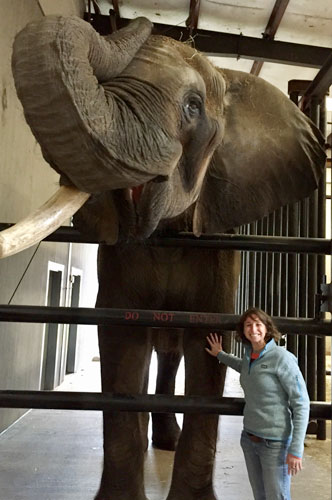 While obesity has been linked to abnormal ovarian cycles in other large mammals, the new findings suggest there is not an association between body fat and reproductive cycling in zoo elephants.With low birth rates, the sustainability of a zoo African elephant population is in question. A new study from University of Alabama at Birmingham researchers reveals that there is no relationship between how fat a zoo African elephant is and her reproductive cycling status.
While obesity has been linked to abnormal ovarian cycles in other large mammals, the new findings suggest there is not an association between body fat and reproductive cycling in zoo elephants.With low birth rates, the sustainability of a zoo African elephant population is in question. A new study from University of Alabama at Birmingham researchers reveals that there is no relationship between how fat a zoo African elephant is and her reproductive cycling status.
While obesity has been linked to abnormal ovarian cycles in other large mammals, the new findings suggest there is not an association between body fat and reproductive cycling in zoo elephants.
Daniella Chusyd, a doctoral candidate in the Department of Nutrition Sciences, recently published new research in Obesity highlighting data she and her team collected from zoo African elephants. Chusyd and colleagues quantified, for the first time, total fat mass in African elephants. Rather than a direct measure of body fat, previous studies have relied on a body condition score, or BCS, to categorize whether elephants are obese. According to the study, BCS is a visual, subjective assessment of subcutaneous body fat stores.
“Previous studies have demonstrated a positive association between body condition score or body mass index and rates of reproductive acyclicity (not having a menstrual cycle) in zoo African elephants, and there is evidence in other species linking body composition to reproductive impairments,” Chusyd said. “More than 50 percent of zoo African elephants in the United States exhibit irregular reproductive cycles.”
Chusyd and colleagues set out to determine whether there was a relationship between obesity and irregular reproductive cycles.
The team used deuterium dilution, a body composition technique that can be applied to the largest terrestrial mammal, the African elephant. Deuterium is a non-radioactive isotope of hydrogen. When introduced into the body, deuterium, which naturally occurs in all animals based on their food and water source, exchanges with hydrogens in water molecules. This allows researchers to measure the amount of water in the body. There is a relationship between how much water is in the body and fat free mass, and when total body water is measured, the fat free mass and fat mass can be calculated.
“To our knowledge, this is the first time deuterium dilution has been used in the elephant, and — because of this study — we now have an idea of the African elephant’s range in body fat, which ran between 5.24 and 15.97 percent,” Chusyd said. “Although we had a small sample size, we did not find that zoo African elephants with abnormal reproductive cycles had more fat. These results highlight potential and interesting differences in determining obesity status using visual versus measured fat stores.”
| “Although we had a small sample size, we did not find that zoo African elephants with abnormal reproductive cycles had more fat. These results highlight potential and interesting differences in determining obesity status using visual versus measured fat stores.” |
According to Chusyd, although the data suggest that having more fat does not necessarily mean a female will not cycle, increased obesity may be important for other health reasons. In the study, the team found a relationship between fat, glucose and insulin. There is also the potential risk of excess fat, and therefore greater body weight, impacting foot and joint issues. As observed in other species, this can contribute to the production of larger calves and subsequent difficult births.
Chusyd, her mentor Tim Nagy, Ph.D., professor in the Department of Nutrition Sciences, and co-adviser Janine Brown, Ph.D., a reproductive physiologist at the Smithsonian Conservation Biology Institute, are studying the association between fat with metabolic and reproductive hormones and physical activity levels in female and male Asian elephants in zoos across North America.